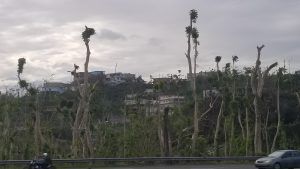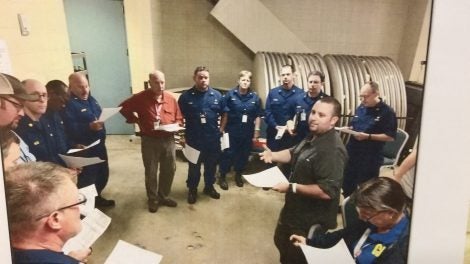December 8, 2017—When the Department of Health and Human Services (HHS) put out a call for government workers to respond to Hurricane Maria in Puerto Rico, Harvard T.H. Chan School of Public Health grad Michael Grant, SM ’13, ScD ’16, didn’t hesitate to volunteer. Grant, who works for the National Institute for Occupational Safety and Health (NIOSH), spent 25 days on the island helping to assess the state of the island’s medical infrastructure in the wake of the storm.
Maria devastated Puerto Rico in late September, killing more than 50 people—though the mayor of San Juan, Puerto Rico’s capital, has said she believes the death toll could be much higher. The storm also left much of the U.S. territory without electricity and clean water. “The amount of damage varied by location but we did not visit anywhere that had no damage,” Grant said. “Health care is complicated because of the [damage]. The lack of power and potable water puts strain on the system to provide for the population. There is also a shortage of providers in some areas because there were doctors that left the island. We heard from a few clinics that the doctors do not plan to return.”
Each day during his deployment Grant and a small team would be assigned to visit medical facilities, including hospitals, health clinics, and diagnostic and treatment centers. They would assess the damage and then report back to the Puerto Rico Department of Health, which allowed the agency to prioritize where to send resources. The team Grant worked with was eventually able to streamline this data collection process and turn it into an app that can be used in future disaster response efforts.

In the midst of suffering and destruction Grant was struck by the incredible resilience of people in Puerto Rico—particularly health care workers who were providing care without electricity and internet access. He recalled seeing a health clinic pharmacist using an old-fashioned paper ledger to track medications and insurance claims. Grant says the woman didn’t know when she would be paid, but that wasn’t the priority. “The main goal [was] to get medication to people who need it.”
In another town, Grant encountered a doctor using a cooler to transport vaccines between her house and her clinic, because the clinic didn’t have the ability to refrigerate them overnight. “Vaccines are in short supply and the doctor was the only one who worked at the clinic that had stable power from the grid at home. There were many more stories like these that we either experienced or heard about every day.”
Grant says his education at Harvard Chan School helped prepare him for the unique challenges he faced in Puerto Rico. “My work at the School focused on workplace inspections and identifying hazards,” Grant said, adding that his background in both health care and commercial construction prepared him to go into damaged buildings. “[In Puerto Rico] we had to be continuously aware of our surroundings and hazards, particularly when we were inside hospitals and clinics. We never knew what the status was going to be of the buildings we were visiting.”
photos: Michael Grant
